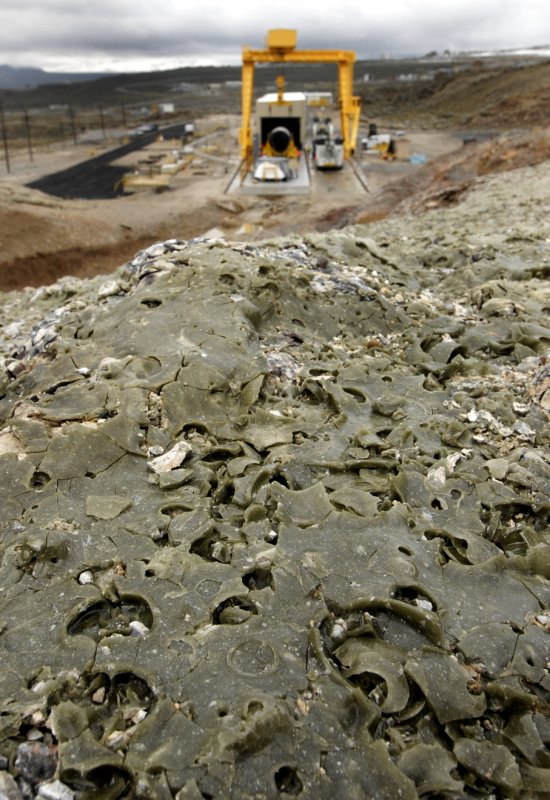SHAZAM!!! Like a mighty bolt of lightning, NASA’s new Ares I rocket first stage motor will be tested later this month sending a plume of fire reaching temperatures more than 3300 degrees Fahrenheit and smoke hurdling for hundreds of yards.
The five-segment solid rocket development motor, or DM-1, will be tested at Alliant Techsystem’s (ATK) test stand in Promontory, Utah on August 27. An interesting byproduct of the test is a unique geographical change that will take place when 50 cubic yards of sand is transformed into a shimmering glass field.

The heritage of shuttle motor testing can be seen in the foreground with a glass field,
created assand used to protect the test stand was heated to temperatures more
than 3,300 degrees Fahrenheit. In the distance, preparations for the first ground
test of the Ares I Development Motor 1 (DM-1) have begun at ATK’s facility
in Promontory, Utah. (ATK)
The art of glass making has been around for centuries. No one knows exactly when or where glass was first made. Evidence shows that it may have originated in Mesopotamia, where pieces of glass have been found, believed to date from the third millennium BC.
When Googling the term “making glass” on the Internet you will learn the process involves basic materials like sand, soda and lime. It also requires very high heat in excess of about 2,912 degrees Fahrenheit.
But engineers at NASA and ATK will use a slightly different method when they conduct the first full-scale, full-duration test firing of the first stage motor for the Ares I rocket.
Four dump truck loads of sand are placed over the aft end of the test stand as a thermal protection barrier to the concrete pad. The intense temperatures escaping the motor at Mach 3, penetrate the sand six inches deep, as the result, a glass field is formed in the wake of the plume.
“The glass has a green tint to it based on the minerals that are in the sand,” said Kevin Rees, director of test and research services at ATK Space Systems. “It eventually crumbles and erodes as it is exposed to weather elements, but right after a test it is fun to see the glimmer reflecting off the glass that was sand a few minutes before.”
So the next time you see a test of a solid rocket motor, you’ll know that this ultimate “high temp” oven is doing more than just paving the path for America’s future in space.
For more information about the Ares rockets or to watch the DM-1 hot fire test live, visit:

Sounds like a good place to build a house. With all the new mortgage programs, ANYTHING is prime real estate.
> On Aug 27, 2009 07:07:29 PM guest wrote:
> …just like the other rocket test on the space shuttle oh well..$$$…
> another round of wasted taxpayer money for me and you there…
And why is it you come to this site again? Do you actually have an interest in space flight and space exploration? If so, surely you realize it is an extremely complex and precise endeavor. It’s not like you can build this stuff out of Legos, you know.
If you came here just to whine and complain, this isn’t the place for it… write your congressional representative, scream into a pillow, or shake your head. But don’t fool yourself into thinking your little jab at the economics of the space program is going to change anything.
After my grandad’s work on the Manhattan project, the USG presented the dept heads and leading scientists with a chunk of “trintite”(*) from the first atomic test, encased in leaded crystal.
(*) Bubbled green glass that was once sand.
I thought folks would appreciate the comparitive analysis of the heat generated.
The program is heroic and the engineers and scientists are our heroes.Press on knowing you all have our unconditional support.
We will support your work.
It’s good fun with some knowledge.I think that this event is supposed to be used to produce some useful byproducts.
Unfortunately, the Obama administration is cutting funding for the Constellation program. It doesn’t surprise me. They have no vision for the future.
“2,912 degrees Fahrenheit” … what is that in groats? Firkins? NASA went metric decades ago. The whole world is interested in this project. Please use units the whole world can understand.